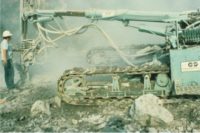Safety advocates angry, industry happy over silica rule delay

Reactions to OSHA’s decision to delay enforcing the federal standard reducing permissible exposure to silica dust have been mixed – and strong. The rule was announced in March 2016 and was scheduled to take effect June 23, 2017.
“With construction season underway, three months of delay means that millions of workers will be exposed to hazardous silica dust that will make them sick and take their lives,” said Marcy Goldstein-Gelb, co-executive director of the National Council for Occupational Safety and Health (NationalCOSH.org).
Industry wants a longer delay
As reported earlier on ISHN.com, the Construction Industry Safety Coalition (CISC) -- whose members include the Associated General Contractors of America, the Associated Builders and Contractors and the National Association of Home Builders – said the delay is too short.
The group released a statement saying it “remains concerned about the overall feasibility of the standard in construction and has requested that the Agency delay enforcement for a year."
National COSH co-executive director Jessica Martinez pointed out that the standard was decades in the making.
“It is backed by solid scientific evidence and the experience of workers who have suffered cancer, silicosis and other life-threatening diseases,” said Martinez. There is no reason for delaying this rule, which will save more 600 lives each year.”
Compliance: difficult or not?
In a letter sent last year to the Department of Labor, the CISC said construction employers across all trades were finding compliance “extremely difficult if not impossible for many job tasks.” At issue: Table 1 in the rule, which the coalition said is not a workable compliance option for many in the industry, which means employers have to follow the traditional method of measuring crystalline silica exposure and implementing the hierarchy of controls. “This is almost impossible, however, considering the myriad of exposure environments involved in construction and that laboratories may not be in compliance with the analytical requirements of the standard until 2018,” CISC argued.
Goldstein-Gelb disputed the difficulty of compliance. “Tools to wet down silica dust and vacuum it up are practical, affordable and readily available,” she said. “The new standard was announced more than a year ago and employers are aware of their responsibilities to limit worker exposure.”
Why silica matters
Some 2.3 million workers are exposed to silica dust in their workplaces, including two million construction workers and 300,000 in general industry operations such as manufacturing, foundries and hydraulic fracturing. Including reduced illnesses, fatalities, a reduction in lost time at work, increased productivity and other factors, OSHA estimates the new silica standard will yield a net annual benefit of $7.7 billion to the U.S. economy.
Trump taking aim at OSH regulations
The silica rule delay is consistent with the Trump administration’s avowed agenda to nullify or repeal regulations it says pose a burden on business, many of them worker safety standards, starting with the establishment of a task force to identify regulations that should be repealed.
- The U.S. Senate has struck down the “Volks” rule of OSHA’s recordkeeping rule that gave the agency the ability to cite to issue citations to employers for failing to record work-related injuries and illnesses during the 5-year retention period, contrary to the six-month statute of limitations.
- OSHA has delayed the effective date of its rule to lower beryllium exposure limits for a second time, to May 20, 2017. The agency said in a statement that the change will allow for “additional review into questions of law and policy.”
- The DOL has proposed a delay in the effective date of the final rule on Examinations of Working Places in Metal and Nonmetal Mines -- from May 23, 2017, to July 24, 2017.
- Trump has also taken steps to dismantle the Clean Air Plan, which limits the amount of greenhouse gas emissions that electric power plants in the U.S. can emit.
Looking for a reprint of this article?
From high-res PDFs to custom plaques, order your copy today!






.jpg?t=1721257160)
